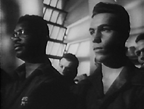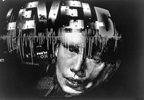Part 7
Okinawa: Colonial Landscape
Immigrants, World War II, the U.S. Occupation, the turmoil of changing eras—Okinawa had plunged into issues beyond the scope of “Japan.” There was an awareness of America, of Asia—and, at the same time, of Okinawa. Under these circumstances, more than a few foreign filmmakers listened to Okinawan voices and concentrated upon Okinawan memories. What aspects of Okinawa did they focus on? What types of visions did they produce? The films in this section recreate the visual poetics born of transnational contacts and exchange.
| 1 | Colonial Elegies, Occupation Clichés |
 Hill of No Return
Hill of No Return
- TAIWAN / 1992 / Mandarin, Japanese, Taiwanese / Color / 35mm / 165 min
Director: Wang Tung
Script: Wu Nien-jen
Photography: Yang Wei-hang
Music: Chen Sheng, Li Cheng-fan
Producer: Hsu Li-kong
Cast: Peng Chia-chia, Huang Pin-yuan, Yang Kuei-mei, Jen Chang-bing
Production Company: Central Motion Picture Corporation
Source: Chinese Taipei Film Archive
Taiwan in the 1920s was under Japanese colonial rule. This film both sarcastically and humorously portrays the humiliation and resilience of people living in a village next to a gold mine run by the Japanese. The film skillfully weaves together colorful episodes, including brothers who ran away from their seasonal apprenticeship and work in the gold mine; a widow who rents them rooms; a Ryukyuan girl working as a servant at the Japanese-run brothel; a half-Japanese Taiwanese boy; and the local villagers. The director expands on the role of the Ryukyuan girl and illucidates the structure between “Japanese,” “Ryukyuan,” and “Taiwanese” under Japanese colonization, revealing a brilliant understanding of human life.
The Teahouse of the August Moon
-
USA / 1956 / Japanese, English / Color / Video (orig. 35mm) / 124 min
Director: Daniel Mann
Script: John Patrick
Based on the novel by: Vern J. Sneider
Photography: John Alton
Music: Saul Chaplin
Producer: Jack Cummings
Cast: Glenn Ford, Marlon Brando, Kyo Machiko
Production Company: MGM
Source: Warner Home Video
Immediately following the Battle of Okinawa, U.S. Army officers from the Military Administration were assigned to teach democracy and develop a self-reliant economic reconstruction plan for the village of Tobiki. The movie humorously portrays the cultural gaps between the officers and villagers. Underneath its comedic touch are the views of soldiers in the U.S. occupation toward the local Okinawans, as well as the Okinawan people’s impressions of the rulers, consisting of China, Japan and America, depending on the situation. In the movie, Okinawans are usually irresponsible and a little cunning, but also tough. This could be due to their experience of living through a long period of oppression, an experience that delivered a tough lesson about how to survive.
| 2 | Sharing the Battle of Okinawa |
 Let There Be Light
Let There Be Light
- USA / 1946 / English / B&W / 16mm (orig. 35mm) / 58 min
Director: John Huston
Script: John Huston, Charles Kaufman
Photography: Stanley Cortez, George Smith, Lloyd Fromm, John Doran, Joseph Jackman
Source: Donald Hall Library, Program in Film and Video Studies, University of Michigan

The documentary Let There Be Light was made by John Houston, renowned for classics including The Maltese Falcon. This film depicts soldiers who suffered nervous breakdowns after their warfront experience during World War II, and their treatment and recovery at army hospitals. A counselor uses hypnotic treatment with a soldier who fought in the Battle of Okinawa and suffered memory loss so severe he is unable to remember his own name. The film conveys the essence of wartime experience, despite the complete absence of battlefront footage.
 Level 5
Level 5
- FRANCE / 1996 / French, Japanese / Color / 35mm / 106 min
Director, Photography: Chris Marker
Music: Michel Krasna
Cast: Catherine Belkhodja
Appearances: Oshima Nagisa and others
Producers: Anatole Dauman, Françoise Widhoff
Production Companies: Les Films de l’Astrophore, Argos Films
Source: Argos Films
This documentary uses fiction to address shared memory of the Battle of Okinawa. Laura tries to get to the most difficult stage, level 5, of the computer program left behind by her late husband. In this are revealed statements by Rev. Kinjo Shigeaki, who witnessed the mass suicide at Tokashiki Island; documentary footage of people jumping to their deaths from cliffs on Saipan Island; and the image of a soldier who lost his memory due to the Battle of Okinawa, portrayed in John Houston’s film Let There Be Light, which was banned from public viewing for thirty years.
